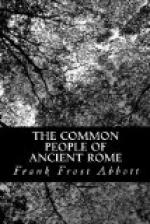One of its primary purposes, as its title indicates, was to investigate the history of Latin words, and in its first number the editor called attention to the importance of knowing the pieces of literature in which each Latin word or locution occurred. The results have been very illuminating. Some words or constructions or phrases are to be found, for instance, only in comedy, satire, and the romance. They are evidently peculiar to vulgar Latin. Others are freely used in these types of literature, but sparingly employed in historical or rhetorical works. Here again a shade of difference is noticeable between formal and familiar usage. The method of the Latinist then is essentially one of comparison and contrast. When, for instance, he finds the word equus regularly used by serious writers for “horse,” but caballus employed in that sense in the colloquial compositions of Lucilius, Horace, and Petronius, he comes to the conclusion that caballus belongs to the vocabulary of every-day life, that it is our “nag.”
The line of reasoning which the Romance philologist follows in his study of vulgar Latin is equally convincing. The existence of a large number of words and idioms in French, Spanish, Italian, and the other Romance languages can be explained only in one of three ways. All these different languages may have hit on the same word or phrase to express an idea, or these words and idioms may have been borrowed from one language by the others, or they may come from a common origin. The first hypothesis is unthinkable. The second is almost as impossible. Undoubtedly French, for instance, borrowed some words from Spanish, and Spanish from Portuguese. It would be conceivable that a few words originating in Spain should pass into France, and thence into Italy, but it is quite beyond belief that the large element which the languages from Spain to Roumania have in common should have passed by borrowing over such a wide territory. It is clear that this common element is inherited from Latin, out of which all the Romance languages are derived. Out of the words, endings, idioms, and constructions which French, Spanish, Italian, and the other tongues of southern Europe have in common, it would be possible, within certain limits, to reconstruct the parent speech, but fortunately we are not limited to this material alone. At this point the Latinist and the Romance philologist join hands. To take up again the illustration already used, the student of the Romance languages finds the word for “horse” in Italian is cavallo, in Spanish caballo, in French cheval, in Roumanian cal, and so on. Evidently all these forms have come from caballus, which the Latinist finds belongs to the vocabulary of vulgar, not of formal, Latin. This one illustration out of many not only discloses the fact that the Romance languages are to be connected with colloquial rather than with literary Latin, but it also shows how the line of investigation opened by Diez, and that followed




